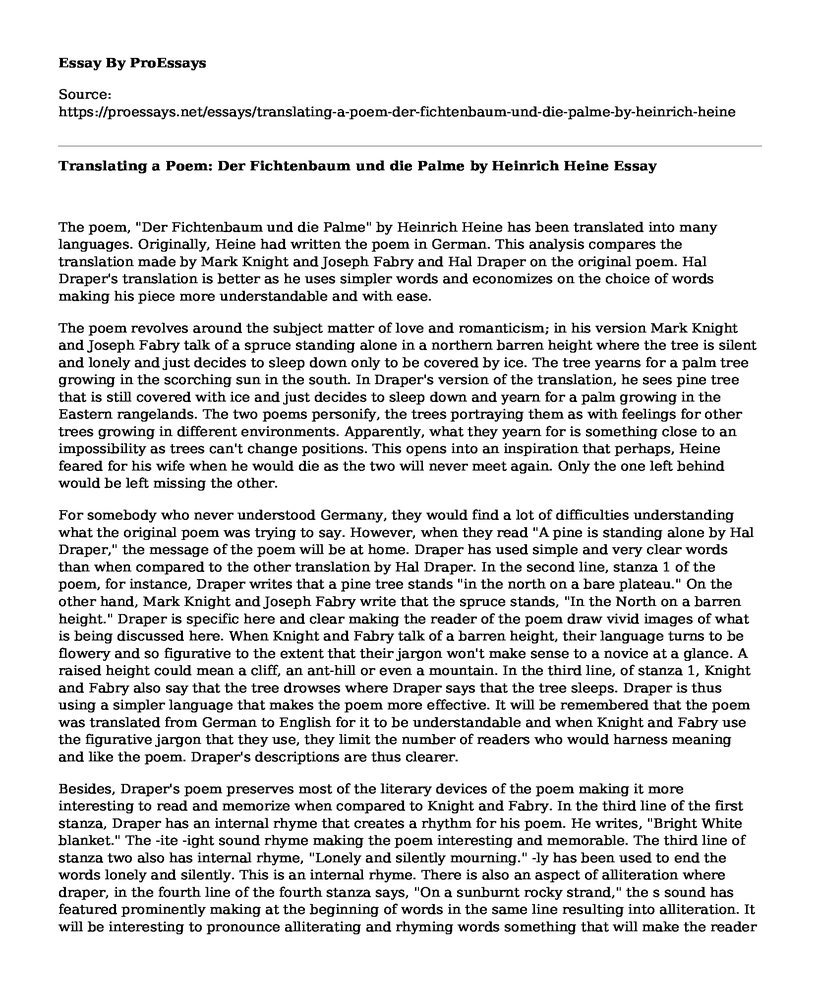The poem, "Der Fichtenbaum und die Palme" by Heinrich Heine has been translated into many languages. Originally, Heine had written the poem in German. This analysis compares the translation made by Mark Knight and Joseph Fabry and Hal Draper on the original poem. Hal Draper's translation is better as he uses simpler words and economizes on the choice of words making his piece more understandable and with ease.
The poem revolves around the subject matter of love and romanticism; in his version Mark Knight and Joseph Fabry talk of a spruce standing alone in a northern barren height where the tree is silent and lonely and just decides to sleep down only to be covered by ice. The tree yearns for a palm tree growing in the scorching sun in the south. In Draper's version of the translation, he sees pine tree that is still covered with ice and just decides to sleep down and yearn for a palm growing in the Eastern rangelands. The two poems personify, the trees portraying them as with feelings for other trees growing in different environments. Apparently, what they yearn for is something close to an impossibility as trees can't change positions. This opens into an inspiration that perhaps, Heine feared for his wife when he would die as the two will never meet again. Only the one left behind would be left missing the other.
For somebody who never understood Germany, they would find a lot of difficulties understanding what the original poem was trying to say. However, when they read "A pine is standing alone by Hal Draper," the message of the poem will be at home. Draper has used simple and very clear words than when compared to the other translation by Hal Draper. In the second line, stanza 1 of the poem, for instance, Draper writes that a pine tree stands "in the north on a bare plateau." On the other hand, Mark Knight and Joseph Fabry write that the spruce stands, "In the North on a barren height." Draper is specific here and clear making the reader of the poem draw vivid images of what is being discussed here. When Knight and Fabry talk of a barren height, their language turns to be flowery and so figurative to the extent that their jargon won't make sense to a novice at a glance. A raised height could mean a cliff, an ant-hill or even a mountain. In the third line, of stanza 1, Knight and Fabry also say that the tree drowses where Draper says that the tree sleeps. Draper is thus using a simpler language that makes the poem more effective. It will be remembered that the poem was translated from German to English for it to be understandable and when Knight and Fabry use the figurative jargon that they use, they limit the number of readers who would harness meaning and like the poem. Draper's descriptions are thus clearer.
Besides, Draper's poem preserves most of the literary devices of the poem making it more interesting to read and memorize when compared to Knight and Fabry. In the third line of the first stanza, Draper has an internal rhyme that creates a rhythm for his poem. He writes, "Bright White blanket." The -ite -ight sound rhyme making the poem interesting and memorable. The third line of stanza two also has internal rhyme, "Lonely and silently mourning." -ly has been used to end the words lonely and silently. This is an internal rhyme. There is also an aspect of alliteration where draper, in the fourth line of the fourth stanza says, "On a sunburnt rocky strand," the s sound has featured prominently making at the beginning of words in the same line resulting into alliteration. It will be interesting to pronounce alliterating and rhyming words something that will make the reader easily remember what they read the poem. This aspect is not well observed by Knight and Fabry something that may distract the novice from reading the poem, and even be unable to remember what they read. The second poem by Draper is thus more interesting and memorable to read than the first version of the translation.Conclusion
In conclusion, A Pine is standing alone by Hal Draper is more a simple translation of, "Der Fichtenbaum und die, Palme," by Heinrich Heine than A spruce by Mark Knight and Fabry. Draper's translation uses simpler words that are devoid of a heavy and figurative jargon as compared to his peers, Knight and Fabry who use heavy English and literary words to translate the poem that was originally written in Germany. Besides, Draper's poem is more of a poem for its artistic use of literary devices than A Spruce is standing alone; there features a lot of rhyme and alliteration that set the rhythm and the tempo of the poem than A spruce is standing alone actually did. While translating a poem, therefore, translators should use the simplest language if possible while trying as much as possible to preserve originality and literary tone of poems.
Cite this page
Translating a Poem: Der Fichtenbaum und die Palme by Heinrich Heine. (2022, Apr 04). Retrieved from https://proessays.net/essays/translating-a-poem-der-fichtenbaum-und-die-palme-by-heinrich-heine
If you are the original author of this essay and no longer wish to have it published on the ProEssays website, please click below to request its removal:
- Learning English as a Foreign Language in Saudi Arabia
- History Curriculum and Pedagogy
- Critical Essay on The Tempest: Scene 4
- Leadership in Education: Understanding Impact & Administration for Student Success
- Brave New World Essay: Community, Identity, Stability
- Analysis of Dis Poetry by Benjamin Zephaniah Essay
- Paper Example on Hope's Feather: Emily Dickinson's Poem







